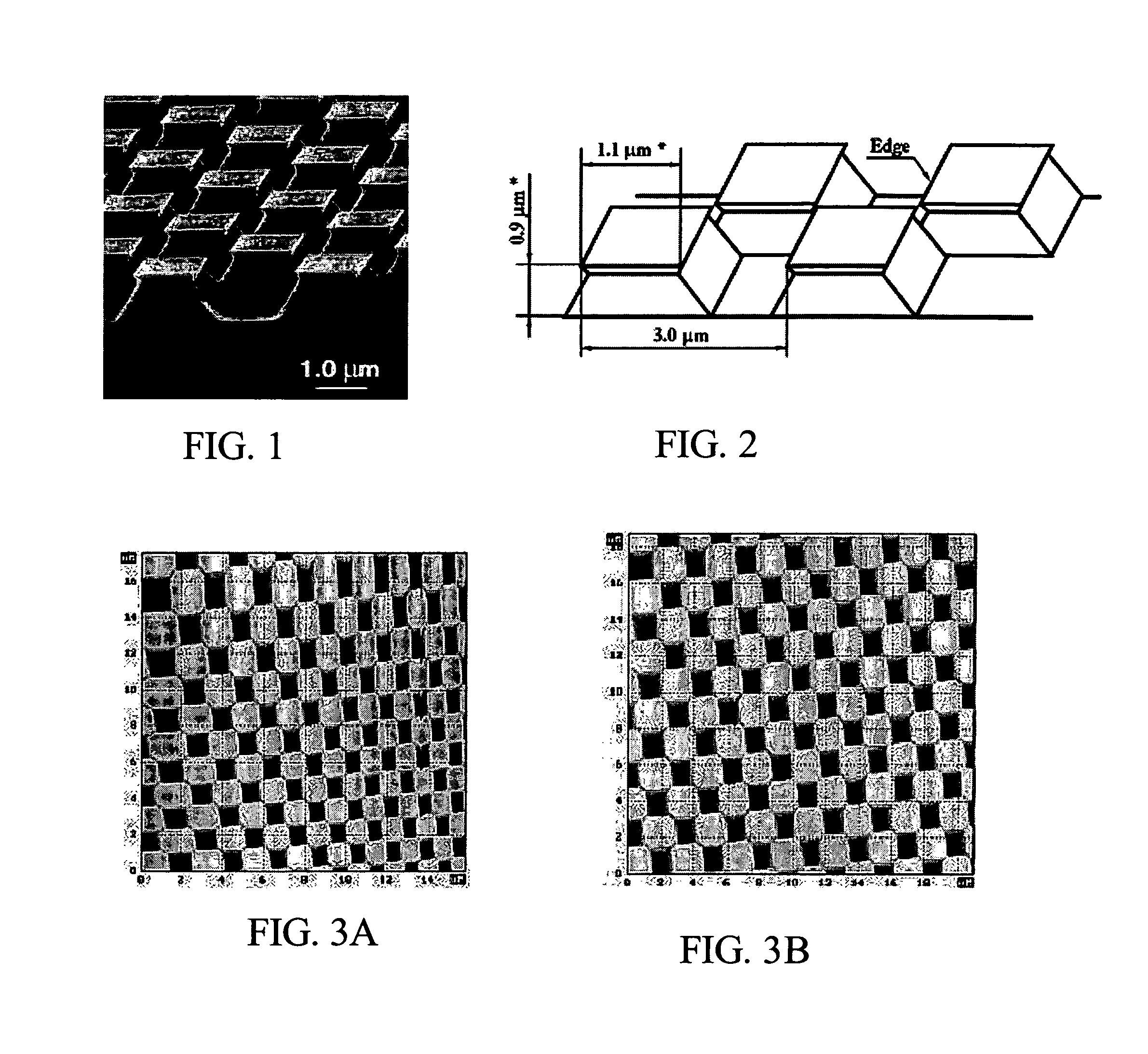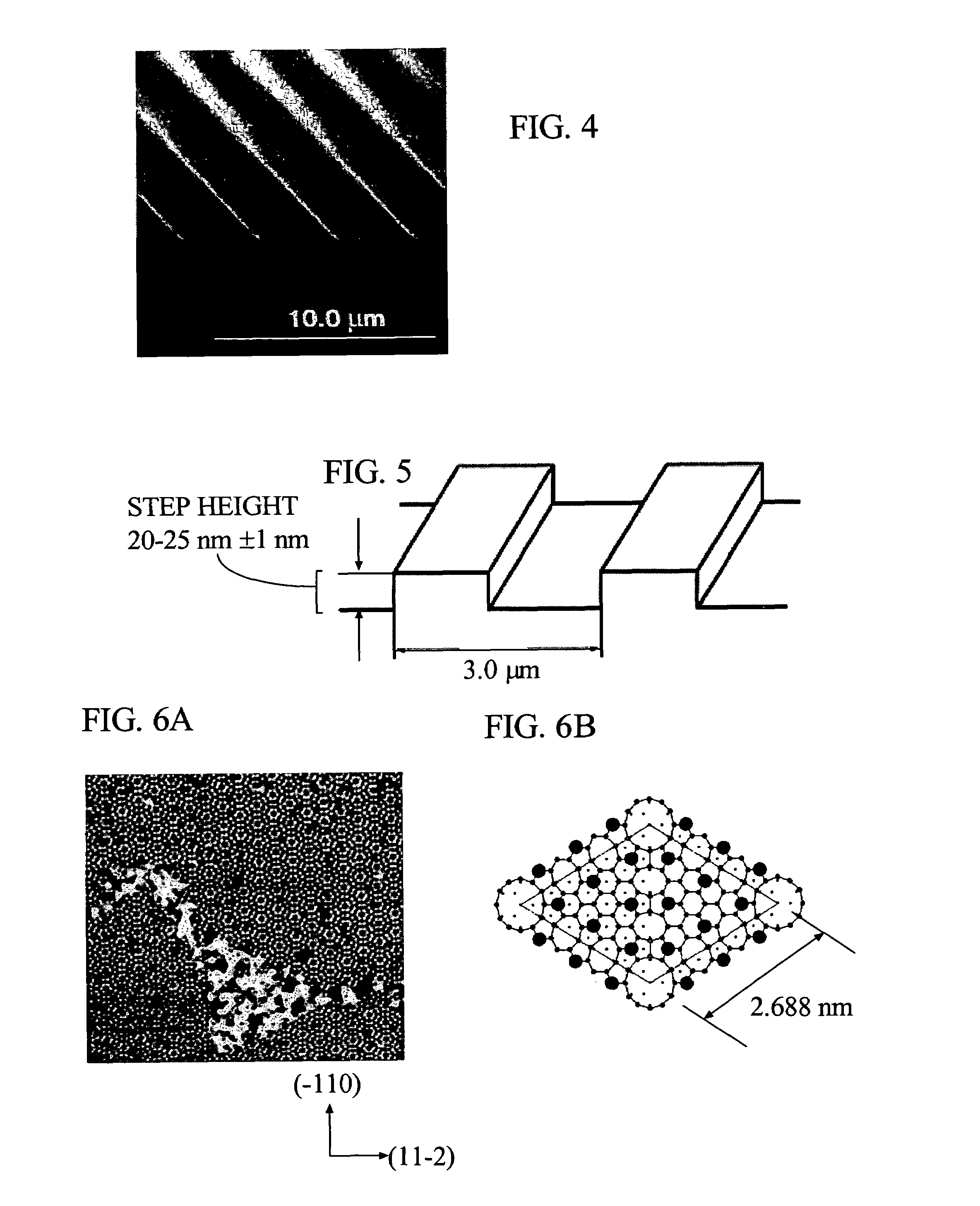Nanometrology device standards for scanning probe microscopes and processes for their fabrication and use
a scanning probe microscope and microscope technology, applied in the direction of instruments, calibration apparatus, using mechanical means, etc., can solve the problems of complex interactions between the scanning probe tip and the sample, the inability to provide absolute length reference, and the inability to provide smaller feature sizes
- Summary
- Abstract
- Description
- Claims
- Application Information
AI Technical Summary
Benefits of technology
Problems solved by technology
Method used
Image
Examples
example 1
[0054]PbSe (clausthalite) or Pb(Se,Te) islands with a high PbSe content can be grown on PbTe (altaite) by molecular bean epitaxy using PbTe and PbSe sources. (111) oriented silicon can be used as a substrate. After desorption of surface layers, a 20 nm thick CaF2 (fluorite) buffer layer is grown at 700° C. Subsequently, at 350° C., a 5 μm thick PbTe buffer layer is grown. The substrate and layers are then exposed to a 380 C environment, and 1.5 nm (approximately 5 monolayers) of PbSe is deposited at a rate of 0.25 nm s−1. The sample is cooled to room temperature at a rate of 1 K s−1, and removed from the epitaxial growth reactor. Crystallographic directions that are perpendicular to the Si wafer substrate normal are marked by partial or total cleavage of the epitaxial structure along the {110} planes that are perpendicular to the Si wafer normal.
[0055]A simplified representation of such a device is shown in FIG. 13. A (111) oriented silicon substrate 1302 is provided with a CaF2 la...
example 2
[0056]PbSe (clausthalite) or Pb(Se,Te) islands with a high PbSe content are grown on PbTe (altaite) using molecular bean epitaxy with PbTe and PbSe sources. (111) oriented silicon is the substrate. After desorption of surface layers, a 3 nm thick CaF2 (fluorite) buffer layer is grown at 700° C. Subsequently, a 4 μm thick PbTe buffer layer is grown at 350° C. The assembly is then exposed to a 380° C. environment and 1.1 nm (about 3.5 monolayers) of PbSe is deposited at a rate of about 0.25 nm s−1. The assembly is then cooled to room temperature at a rate of 1 K s−1 and removed from the epitaxial growth reactor. Crystallographic directions perpendicular to the Si wafer normal are marked by partial or total cleavage of the epitaxial structure along the {110} planes that are perpendicular to the Si wafer normal.
example 3
[0057]PbSe (clausthalite) or Pb(Se,Te) islands with a high PbSe content can be grown on PbTe (altaite) by molecular bean epitaxy using PbTe and PbSe sources. (111) oriented silicon can be used as a substrate. After desorption of surface layers, a 25 nm thick CaF2 (fluorite) buffer layer can be grown at 700° C. At the same temperature, a BaF2 (frankdicksonite) buffer layer with 1 μm thickness is grown. Subsequently at 350° C., a 4 nm thick PbTe buffer layer is grown. The assembly is then heated to about 380° C. and 1.1 nm (approximately 3.5 monolayers) of PbSe is deposited at a rate of 0.25 nm s−1. The assembly is cooled to room temperature at a rate of 1 K s−1 and removed from the epitaxial growth reactor. Crystallographic directions that are perpendicular to the Si wafer normal are marked by partial or total cleavage of the epitaxial structure along the {110} planes that are perpendicular to the Si wafer normal.
PUM
| Property | Measurement | Unit |
|---|---|---|
| Nanoscale particle size | aaaaa | aaaaa |
| Nanoscale particle size | aaaaa | aaaaa |
| Nanoscale particle size | aaaaa | aaaaa |
Abstract
Description
Claims
Application Information
 Login to View More
Login to View More - R&D Engineer
- R&D Manager
- IP Professional
- Industry Leading Data Capabilities
- Powerful AI technology
- Patent DNA Extraction
Browse by: Latest US Patents, China's latest patents, Technical Efficacy Thesaurus, Application Domain, Technology Topic, Popular Technical Reports.
© 2024 PatSnap. All rights reserved.Legal|Privacy policy|Modern Slavery Act Transparency Statement|Sitemap|About US| Contact US: help@patsnap.com










